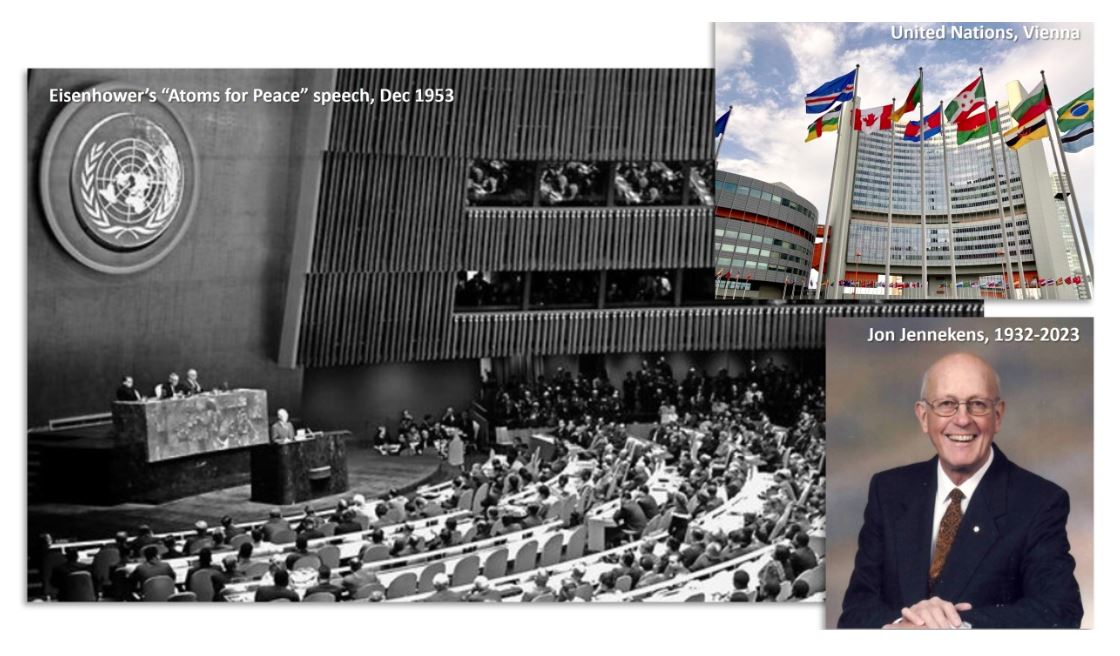|
Saving the world from itself by Jeremy Whitlock November 2023 
It's hard to find a shining example of successful global policy these days, with the world apparently coming apart at the seams. Many of these seams were carefully stitched with tired and bloodied hands in the years after World War II, by folks determined to prevent that level of obscenity from ever happening again. However, from the depths of that obscenity came one of our highest ideals: that every citizen of earth deserves to share the liberating potential of nuclear energy, and not live in fear of its misuse. The symbolism was intoxicating: the apex of science from the first half of the 20th century, triumphing over the apex of evil from that same era. Thus it was, 70 years ago on December 8, 1953, that US President Eisenhower stood before a young United Nations and encouraged the world to follow his vision of Atoms for Peace. From this ideal emerged the International Atomic Energy Agency (IAEA) in 1957: a steward for the nuclear path out of Eisenhower's "dark chamber of horrors", toward "peace and happiness and well-being". At the end of the 1960s this path was mapped in the Treaty on the Non-Proliferation of Nuclear Weapons (NPT), establishing the means by which nuclear-armed States would prevent the spread of this threat (and reduce its current level), while supporting the inalienable right for all States to pursue nuclear energy for peaceful purposes. Over half a century later, the NPT – weathered and weary – remains one the most subscribed-to treaties on the planet, and arguably one of the most successful (with the notable exception of its principle for disarmament). The NPT obliges non-nuclear-weapon States to accept full IAEA safeguards on their nuclear programmes, and nuclear-weapon States not to transfer weapons know-how. Thus, the IAEA not only lights the pathway of Eisenhower's "Atoms for Peace"; it enables it. Canada has held high the IAEA torch from the beginning, playing a role in its founding, administration, and technical activities without interruption – eight Canadians have chaired the IAEA Board of Governors (nine if you include France's Bertrand Goldschmidt – a key figure in the Canadian wartime nuclear programme). Today some 60-70 Canadian ex-pats contribute their expertise to the IAEA's various departments, most sharing a common history from Chalk River, the CNSC, or the uranium mining and reactor operation sectors. This key support includes the Department of Safeguards, where Canada has played a unique role as one of the nuclear pioneer nations – among the first to accept comprehensive safeguards and subsequent enhancements, with a vast nuclear fuel cycle and a breadth of capabilities to match (the first State that could have pursued nuclear weapons but chose not to). A Canadian helmed the IAEA Safeguards department at the close of the 1980s – an era sometimes viewed as "the end of innocence" for the department, when the discovery of Iraq's clandestine nuclear weapons programme (despite full safeguards), and equally concerning developments in North Korea and elsewhere, led to an extensive strengthening of safeguards capabilities through the 1990s that sharpened the focus on clandestine scenarios. The Canadian leading the IAEA Department of Safeguards to this existential awakening was Jon Jennekens, Deputy Director General for IAEA Safeguards from 1987 to 1993. Prior to this Jennekens headed Canada's nuclear regulator (now the Canadian Nuclear Safety Commission, CNSC) after rising through its ranks as a staff member. And of course, before that Jennekens did a stint at Chalk River Laboratories – as everyone in the Canadian nuclear sector seems to do (at least back then). Jon Jennekens, officer of the Order of Canada, and one of the nicest, most good-natured souls you could meet, passed away this past September – just shy of his 91st birthday. Jennekens' generation built a world based on peace and respect, at a time when the stench of the ashes of the previous world was still in the nostrils. He believed in the value of science to humanity, and in harmony – with nature; with each other. For Eisenhower's generation – which won us the opportunity to live better, and for Jennekens' – which built a world where we did just that, let's hope the stitches hold.
|
|
Discussion welcome. ©2024 Jeremy Whitlock
|
|
